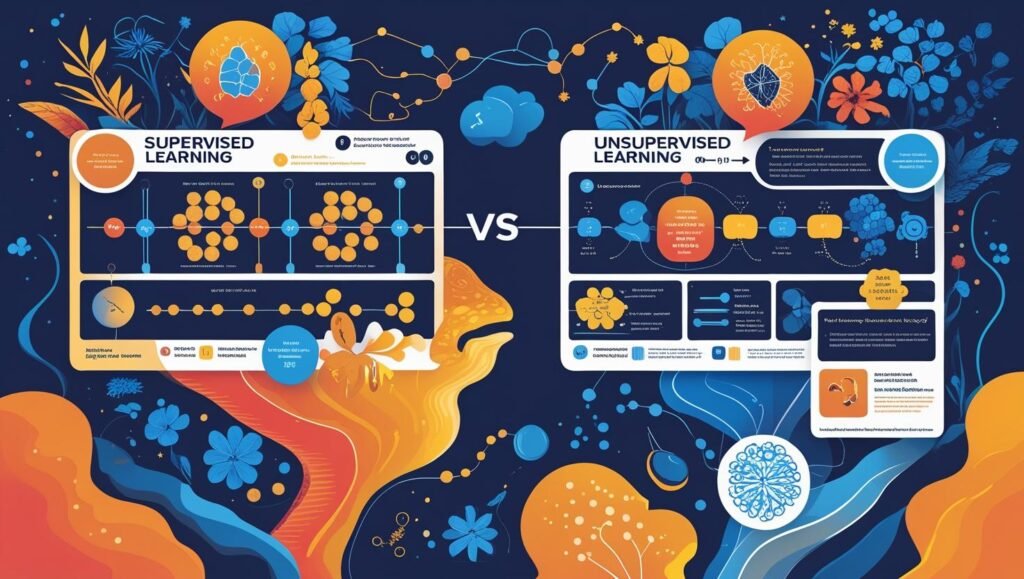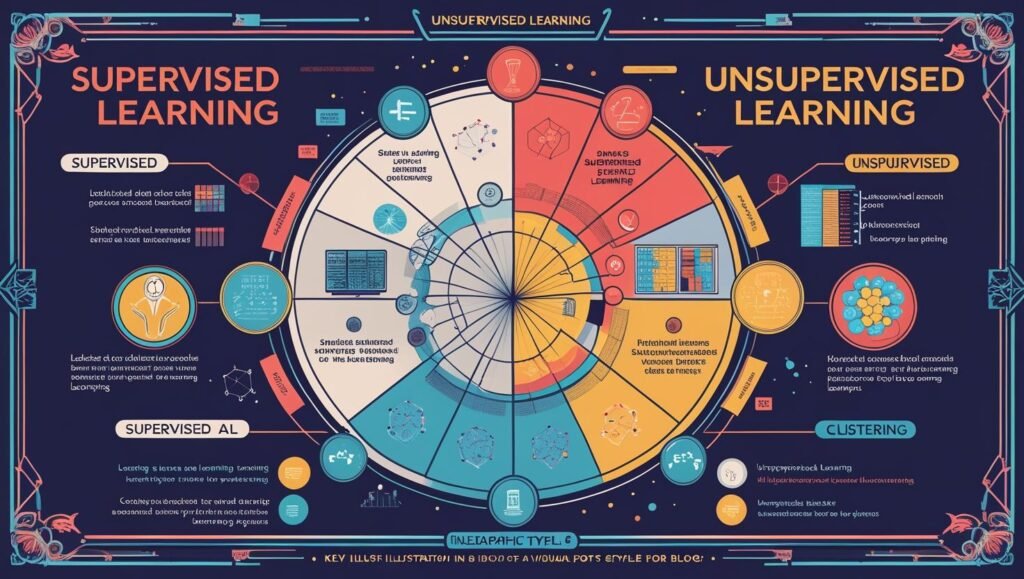Supervised vs. Unsupervised Learning Explained: Key Differences and Use Cases

In the ever-evolving world of artificial intelligence, understanding the distinction between supervised and unsupervised learning is essential for anyone looking to harness the power of data. While both techniques aim to extract insights from data, they approach the task in fundamentally different ways, catering to various needs and scenarios.
Supervised learning operates with labeled datasets, learning from examples to make predictions, while unsupervised learning delves into the unknown, identifying patterns and relationships in unlabelled data. In this exploration, we’ll unravel these concepts, delve into their key differences, and highlight practical use cases that illustrate how they can be applied in real-world situations.
Whether you’re a data scientist, a business professional, or simply curious about AI, understanding these methods can significantly enhance your decision-making and strategy development in today’s data-driven landscape. Join us as we navigate through the nuances of these pivotal learning paradigms.
What is Supervised Learning?
Supervised learning is a type of machine learning where an algorithm is trained on a labeled dataset. This means that each training example is paired with an output label. The goal of supervised learning is to learn a mapping from inputs to outputs that can be applied to new, unseen data. Essentially, the algorithm learns from the training data by making predictions and adjusting based on the correctness of these predictions.
One of the main advantages of supervised learning is its ability to generalize from the training data to unseen situations. This is achieved through a process called training, where the algorithm iteratively adjusts its parameters to minimize the difference between its predictions and the actual labels in the training set. This process continues until the model reaches a desired level of accuracy. Supervised learning is particularly useful for tasks where the relationship between input and output data is well understood and can be clearly defined.
Common applications of supervised learning include classification and regression problems. In classification, the goal is to predict discrete labels such as spam detection in emails or disease diagnosis in medical imaging. In regression, the aim is to predict continuous values, like forecasting stock prices or estimating property values. Supervised learning models can be powerful tools in making accurate predictions and driving informed decisions across various domains.
What is Unsupervised Learning?
Unsupervised learning, on the other hand, deals with datasets that do not have labeled outputs. The primary objective of unsupervised learning is to infer the natural structure present within a set of data points. Unlike supervised learning, there is no explicit teacher to guide the learning process. Instead, the algorithms must discover patterns and relationships in the data on their own.
Clustering and association are two of the most common tasks in unsupervised learning. Clustering involves grouping data points into clusters such that points in the same cluster are more similar to each other than to those in other clusters. This technique is widely used in market segmentation, image compression, and social network analysis. Association learning focuses on finding rules that describe large portions of the data, such as market basket analysis, where the goal is to identify products that frequently co-occur in transactions.
Unsupervised learning can also be employed for dimensionality reduction, which simplifies high-dimensional data while retaining its essential structure. Techniques like Principal Component Analysis (PCA) and t-Distributed Stochastic Neighbor Embedding (t-SNE) are commonly used for this purpose. By reducing the number of features in the data, these methods can help in visualizing complex datasets and improving the performance of other machine learning algorithms by removing noise and redundancy.
Key Differences

The most fundamental difference between supervised and unsupervised learning lies in the presence of labeled data. Supervised learning relies on labeled inputs and outputs to guide the learning process, whereas unsupervised learning works with unlabeled data and seeks to uncover hidden patterns without explicit guidance. This distinction significantly influences the way these methods are applied and the types of problems they are best suited to solve.
Another key difference is the objective of the algorithms. In supervised learning, the goal is to map inputs to outputs accurately, which involves predicting labels for new data points. This makes supervised learning ideal for tasks where specific predictions are required. Conversely, unsupervised learning aims to explore the underlying structure of the data, making it more suitable for tasks like clustering, anomaly detection, and data visualization, where the focus is on understanding data relationships rather than making specific predictions.
The complexity and computational requirements also vary between the two approaches. Supervised learning models often require extensive labeled datasets and can be computationally intensive due to the iterative training process. In contrast, unsupervised learning algorithms can operate on smaller datasets and typically require less computational power, as they do not need to learn from labeled examples. However, the trade-off is that unsupervised models may require more sophisticated techniques to interpret and validate the discovered patterns.
Common Algorithms in Supervised Learning
Supervised learning encompasses a wide range of algorithms, each suited to different types of tasks and data. One of the most well-known algorithms is the Linear Regression, which models the relationship between a dependent variable and one or more independent variables. Linear regression is widely used for predictive analytics, such as forecasting sales or determining the impact of marketing campaigns.
Another popular algorithm is the Decision Tree, which splits the data into subsets based on the value of input features. Decision trees are intuitive and easy to interpret, making them useful for classification tasks like determining whether a customer will buy a product based on their demographic information. Random Forests extend decision trees by building multiple trees and combining their predictions, enhancing accuracy and robustness.
Support Vector Machines (SVMs) are powerful algorithms for classification and regression tasks. They work by finding the hyperplane that best separates different classes in the feature space. SVMs are particularly effective in high-dimensional spaces and are used in applications like text classification and image recognition. Neural Networks, which are the foundation of deep learning, are also widely used in supervised learning. They consist of layers of interconnected nodes that can learn complex patterns in the data, making them suitable for tasks like speech recognition and autonomous driving.
Common Algorithms in Unsupervised Learning
Unsupervised learning also boasts a variety of algorithms, each designed to uncover different types of patterns in the data. K-Means Clustering is one of the most commonly used algorithms. It partitions the data into K clusters by minimizing the distance between data points and the centroid of their assigned cluster. K-Means is widely used in customer segmentation, image compression, and anomaly detection.
Hierarchical Clustering is another popular technique that builds a tree of clusters by iteratively merging or splitting existing clusters. This method is useful for understanding the hierarchical structure of the data and is often used in gene expression analysis and document clustering. Unlike K-Means, hierarchical clustering does not require the number of clusters to be specified in advance.
Principal Component Analysis (PCA) is a dimensionality reduction technique that transforms the data into a new coordinate system, where the greatest variance by any projection of the data comes to lie on the first coordinate (the first principal component), the second greatest variance on the second coordinate, and so on. PCA is commonly used for data visualization and noise reduction in high-dimensional datasets. t-Distributed Stochastic Neighbor Embedding (t-SNE) is another dimensionality reduction technique that is particularly effective for visualizing complex, non-linear relationships in the data, making it a valuable tool for exploratory data analysis.
Use Cases for Supervised Learning
Supervised learning has a broad range of applications across various industries. In the healthcare sector, it is used for disease diagnosis and predicting patient outcomes. For example, algorithms can be trained on labeled medical images to identify tumors or other abnormalities in X-rays and MRIs. Similarly, supervised learning models can analyze patient records to predict the likelihood of readmission or the effectiveness of different treatments.
In the financial industry, supervised learning is employed for credit scoring and fraud detection. By training models on historical transaction data, banks can predict the creditworthiness of loan applicants and identify potentially fraudulent transactions in real-time. Marketing and sales teams also benefit from supervised learning through customer segmentation and targeted advertising. By analyzing past purchase behavior and demographic information, companies can predict which products a customer is likely to buy and tailor their marketing strategies accordingly.
Moreover, supervised learning plays a crucial role in improving user experience in technology products. Voice assistants like Siri and Alexa use supervised learning to understand and respond to user commands. Similarly, email services use supervised learning algorithms to filter out spam and prioritize important messages. In autonomous vehicles, supervised learning models are used to detect objects, recognize traffic signs, and make driving decisions, enhancing safety and efficiency on the roads.
Use Cases for Unsupervised Learning
Unsupervised learning is equally versatile, with applications spanning numerous fields. In marketing, it is used for market segmentation, allowing companies to group customers based on their purchasing behavior and preferences. This enables more personalized marketing campaigns and better customer service. Retailers also use unsupervised learning for inventory management, identifying patterns in sales data to optimize stock levels and reduce waste.
In cybersecurity, unsupervised learning is employed for anomaly detection, which helps in identifying unusual patterns that may indicate security breaches or fraudulent activities. By analyzing network traffic and user behavior, unsupervised models can detect potential threats in real-time, providing an additional layer of security for organizations. In the field of natural language processing, unsupervised learning techniques are used for topic modeling, where algorithms identify themes and patterns in large text corpora, enabling better organization and retrieval of information.
Furthermore, unsupervised learning is instrumental in the field of bioinformatics, where it is used to analyze genetic data and identify patterns that can lead to new discoveries in genetics and medicine. For instance, clustering algorithms can group similar gene expression profiles, helping researchers understand the genetic basis of diseases and develop targeted therapies. In the realm of recommendation systems, unsupervised learning algorithms analyze user behavior and preferences to suggest products, movies, or music, enhancing user satisfaction and engagement.
What to Choose for your Projects

Choosing between supervised and unsupervised learning depends on several factors, including the nature of the data, the specific problem at hand, and the desired outcomes. One of the primary considerations is the availability of labeled data. If you have access to a labeled dataset where the relationship between inputs and outputs is clearly defined, supervised learning is likely the better choice. This approach is ideal for tasks that require specific predictions, such as classification and regression.
On the other hand, if you are dealing with unlabeled data and your goal is to explore and understand the underlying structure of the data, unsupervised learning is more appropriate. This method is suitable for tasks like clustering, anomaly detection, and dimensionality reduction, where the focus is on discovering patterns and relationships rather than making precise predictions. Unsupervised learning can also be a valuable preliminary step in data analysis, helping to uncover insights that can inform subsequent supervised learning models.
Another important factor to consider is the complexity and computational requirements of the algorithms. Supervised learning models often require extensive labeled datasets and can be computationally intensive due to the iterative training process. In contrast, unsupervised learning algorithms can operate on smaller datasets and typically require less computational power. However, the trade-off is that unsupervised models may require more sophisticated techniques to interpret and validate the discovered patterns.
Conclusion :
In conclusion, both supervised and unsupervised learning are powerful techniques that offer unique advantages and are suited to different types of problems. Supervised learning excels in making accurate predictions based on labeled data, making it ideal for tasks like classification and regression. Unsupervised learning, on the other hand, is invaluable for exploring and understanding the underlying structure of unlabeled data, making it suitable for clustering, anomaly detection, and dimensionality reduction.
As the field of machine learning continues to evolve, we can expect to see further advancements in both supervised and unsupervised learning techniques. The integration of these methods with other technologies, such as deep learning and reinforcement learning, will likely lead to even more sophisticated and powerful models. Additionally, the increasing availability of large datasets and advancements in computational power will enable the development of more accurate and efficient algorithms.
Future trends in machine learning also include the development of hybrid models that combine the strengths of both supervised and unsupervised learning. These models can leverage the labeled data to make accurate predictions while also uncovering hidden patterns in the unlabeled data. Furthermore, the growing emphasis on explainability and interpretability in AI will drive the development of models that are not only accurate but also transparent and understandable.
By understanding the key differences and use cases of supervised and unsupervised learning, data scientists, business professionals, and AI enthusiasts can make more informed decisions and leverage these techniques to drive innovation and growth in their respective fields. As we continue to navigate the data-driven landscape, the ability to effectively apply these learning paradigms will be crucial in unlocking the full potential of artificial intelligence.
For the latest insights and updates, be sure to explore our AI Trends & News and stay ahead in the world of artificial intelligence.

Pingback: Machine Learning: A Beginner-Friendly Guide - AI insights world
Pingback: Manus AI Agent Overview - AI insights world